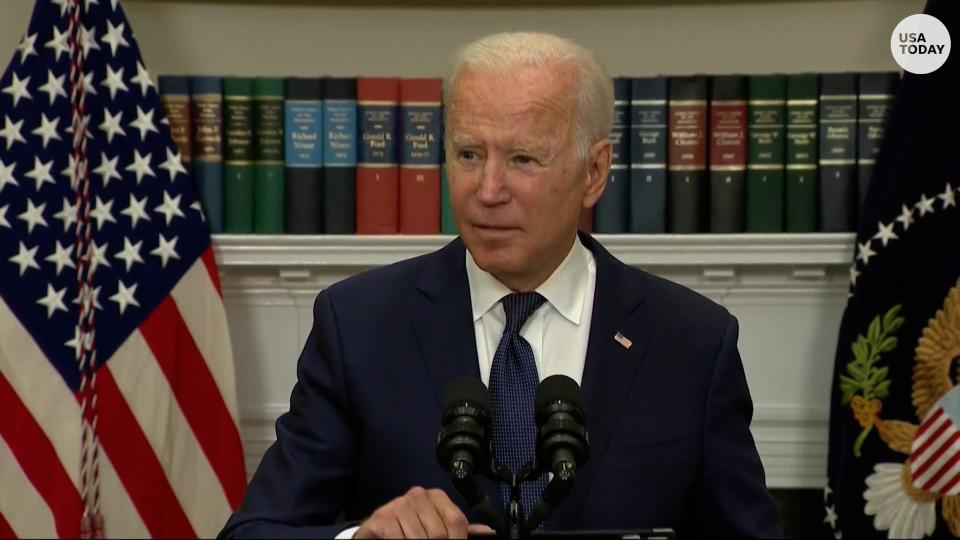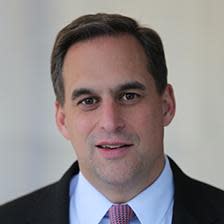Biden's withdrawal from Afghanistan was a strategic failure
- Oops!Something went wrong.Please try again later.
On Sept. 11, 20 years after the 9/11 attacks, the Taliban held a solemn ceremony at the presidential palace in Afghanistan’s capital, Kabul. Prime Minister Mohammad Hassan Akhund raised the Taliban’s white flag and celebrated the group’s victory over the United States. The symbolism was difficult to miss. The extremist Taliban, who were overthrown by the United States two decades earlier, were now back in power.
It wasn’t supposed to happen that way.
President Joe Biden promised during his election campaign to end the U.S. military involvement in Afghanistan. While he kept that commitment, the United States paid a steep price. The U.S. withdrawal was poorly planned and executed. It led to the death of 13 U.S. service members, jettisoned democracy in Afghanistan, wiped out hard-won progress on women’s rights and increased the terrorism threat from al-Qaida, the Islamic State and other groups.

President Biden’s objectives in Afghanistan were laudable: to withdraw U.S. forces from a war he deemed unwinnable and to shift the U.S. focus to competition with China. “We have to shore up American competitiveness to meet the stiff competition we’re facing from an increasingly assertive China.” he remarked in April, continuing that “it's time to end the forever war.”
Opinions in your inbox: Get a digest of our takes on current events every day
The administration achieved some of its objectives. It successfully withdrew all U.S. military forces from the country by Aug. 30. Officials are putting the final touches on the National Security Strategy and National Defense Strategy that formally shifts U.S. attention to the Indo-Pacific region to compete with China.
Demise of democracy
Yet the withdrawal was a strategic failure. First, the evacuation of U.S. citizens and Afghans was a debacle. Searing images of terrified Afghans swarming around U.S. C-17s as they took off from Kabul's international airport – with Afghans falling to their deaths – gripped the world. These videos and photographs were every bit as dramatic as those taken during the inglorious U.S. withdrawal from Vietnam in 1975 at the fall of Saigon.
To make matters worse, the Islamic State affiliate in Afghanistan – known as Islamic State Khorasan, or ISIS-K – conducted a brutal attack at the Kabul airport that killed more than 150 people, including the U.S. military members. No American had been killed in combat in Afghanistan during the previous 18 months.
Second, Afghanistan’s return to the Dark Ages has tarnished America’s reputation as a beacon of freedom. According to Freedom House, a Washington-based nongovernmental organization, democracy has sustained heavy losses, with 15 consecutive years of declining global freedom. Afghanistan is now the latest victim.
Taliban leaders disparage democracy as a corrupt invention of the West. It is no surprise, then, that the Taliban’s main great power backers – China and Russia – have gloated over the demise of democracy in Afghanistan.
Women’s rights have also been gutted. Women are banned from participating in the Taliban’s main political bodies, and the Taliban have barred many women and girls from school and the workforce.
Paul Brandus: Jobs, jabs, infrastructure, prosperity, peace: Why isn't Biden doing more to tout his wins?
Women have been the victims of targeted beatings and killings and are prohibited from leaving home without a male guardian.
Third, the U.S. withdrawal sets the stage for a terrorist resurgence. As President Biden explained, the United States' only interest in Afghanistan is "preventing a terrorist attack on America's homeland." But the withdrawal has created the very conditions necessary for a terrorist revival.

It didn’t help that the Taliban released thousands of al-Qaida operatives and other fighters from prisons in Bagram, Kabul and Kandahar. The Taliban then appointed Sirajuddin Haqqani as its first minister of interior. A U.S.-designated terrorist with close links to al-Qaida is the Afghan equivalent of director of the FBI and secretary of the Department of Homeland Security. That’s not reassuring.
U.S. intelligence agencies now assess that both al-Qaida and the Islamic State could conduct attacks outside of Afghanistan in 2022. This outcome was predictable. The Taliban and al-Qaida enjoy longstanding personal relationships, intermarriage and sympathetic ideologies. Al-Qaida leaders have pledged bay’ah, or loyalty, to every Taliban leader since the group’s establishment.
The Taliban have ties with other terrorist groups, such as the Tehrik-e-Taliban in Pakistan, Jaish-e-Mohammed and Lashkar-e-Taiba.
Terror making a comeback
ISIS-K is also making a comeback. On Nov. 2, ISIS-K gunmen attacked the Sardar Mohammad Daud Khan military hospital in Kabul, killing at least 25 people and wounding more than a dozen.
ISIS-K’s ranks have been bolstered by some members of the previous government’s intelligence service and military, which were trained by the United States.
Sunil Srivastava: Rampant corruption crippled Afghanistan. The international community did little to help.
In response to the terrorism challenge, U.S. officials argue that they can conduct an over-the-horizon campaign, much like in Iraq, Syria, Libya, Somalia and Yemen. But this comparison is disingenuous. Unlike those other campaigns, the United States has no local partners in Afghanistan, no nearby bases to fly drones and little intelligence architecture.
We have sadly seen this movie before. On Feb. 15, 1989, the last Soviet forces walked across the “Bridge of Friendship” from Afghanistan to Uzbekistan. It was, ironically, a much better organized and executed withdrawal. Yet an escalating civil war quickly ensued, and Afghanistan became a sanctuary for terrorist groups.
Afghanistan’s future now looks equally grim.
Seth G. Jones is senior vice president and director of the International Security Program at the Center for Strategic and International Studies, a former senior civilian in U.S. Special Operations Command in Afghanistan and author of “Three Dangerous Men: Russia, China, Iran and the Rise of Irregular Warfare.”
You can read diverse opinions from our Board of Contributors and other writers on the Opinion front page, on Twitter @usatodayopinion and in our daily Opinion newsletter. To respond to a column, submit a comment to letters@usatoday.com.
This article originally appeared on USA TODAY: Biden's botched withdrawal in Afghanistan raises risk of terrorist revival

